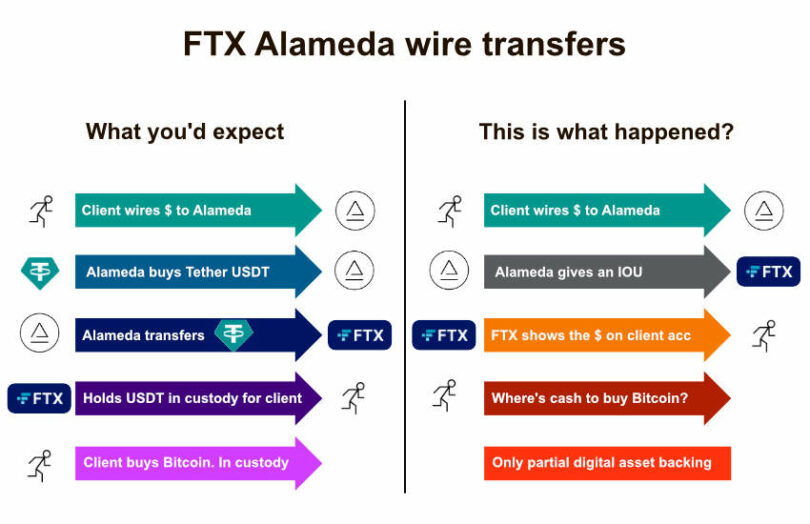Last week Bloomberg reported that prosecutors are investigating potential fraud relating to FTX transfers to the Bahamas, presumably the ones made shortly before the bankruptcy. However, there are unanswered fundamental questions about the early days of FTX, when clients wired money to FTX via Alameda.
Former FTX CEO Sam Bankman Fried (SBF) stated that FTX lacked a bank account in the early days, so customers wired money to Alameda. And these transfers account for a significant amount of the funds owed by Alameda to FTX at bankruptcy.
This raises two related questions:
1. When Alameda received money from clients, why didn’t it buy stablecoins and transfer the coins to FTX?
2. If FTX didn’t receive the cash from Alameda, how did it buy crypto for clients to keep assets fully backed?
Before exploring the questions, let’s look at how fraud is defined. Simplistically, fraud is when someone suffers a loss linked to a misrepresentation. Such as stating your assets are backed one-for-one when they are not. Civil fraud is usually the result of carelessness or negligence. There’s a need to show someone did something on purpose to prove criminal fraud, and this is the one that could potentially carry jail time.
Why didn’t Alameda transfer stablecoins to FTX?
According to Bankman Fried, when clients wired money to Alameda intended for FTX, Alameda essentially considered it an IOU to FTX (IOU is our shorthand). In the FTX books, clients were shown they had money, and the Alameda account at FTX was overdrawn by the same amount.
That looks bad.
If FTX intended to do right by its clients, this treatment is very odd. It goes to heart of whether or not FTX had good intentions toward its clients.
Ignoring how the transaction was treated, going to first principles, this is what should have happened:
- Clients wire money to Alameda
- Alameda buys the equivalent in stablecoins
- Alameda transfers stablecoins to FTX
- FTX now has stablecoins in custody that belong to the client
- The client asks FTX to use stablecoins to buy, say, Bitcoin, which it holds in custody
If this had happened, there would be no intercompany balance between Alameda and FTX.
If this was not the route taken. Why???
Also it’s worth noting that Alameda Research is one of the two largest intermediaries for distributing newly minted Tether stablecoins. Protos found that Alameda has distributed more than a third of all newly minted Tether. And Alameda’s activity is mainly since FTX started.
The vast majority of the newly minted stablecoin – more than $30 billion – has gone directly to FTX.
So it’s not like the option of providing FTX with stablecoins in exchange for the wired money would have seemed odd to Alameda. It would have been by far the most obvious scenario.
And the Protos figures imply that this might have been what happened.
As an aside, during the early days when this methodology for wire transfers was developed, SBF was CEO of both companies, and the headcount was low. It’s inconceivable that SBF wasn’t involved in deciding how to treat the wire transfers.
Stablecoin conclusion:
a. Either Alameda transferred stablecoins, in which case, SBF mistakenly stated the Alameda balance related to the wire transfers when it didn’t. In which case, how did the Alameda balance get so huge?
OR
b. Alameda kept the money and gave FTX an IOU, which looks like a knowingly poor attitude on FTX’s side towards its clients
OR
c. Alameda minted stablecoins but kept them and still gave FTX an IOU, which also looks bad.
How did FTX buy coins for clients without the money?
Let’s assume that when clients wired Alameda, FTX didn’t receive the cash or stablecoins from Alameda (as SBF has stated). So, how did FTX buy currencies for clients?
Without FTX having massive capital buffers, the most likely answer is that FTX client assets were not fully backed. And that’s not just recently.
If all the clients just parked their cash and crypto at FTX and traded spot only, then it might provide an opportunity to prosecute fraud from the start. And there might be a possibility of arguing that that ‘spot only’ clients were defrauded.
However, SBF keeps harping on about some clients agreeing to lend funds and many trading derivatives on margin. He’s trying to argue that it was okay for these clients if the backing was a combination of digital assets and the Alameda IOU.
The issue is the digital assets of ‘spot only’ clients should have been segregated from others to ensure they were always one-to-one backed. Was a lack of segregation negligent or intentional?
That relates back to the first question. Did the creation of the Alameda intercompany balances show a disregard for clients in the first place? If a prosecutor can prove there was intent, then the fraud was a crime.






